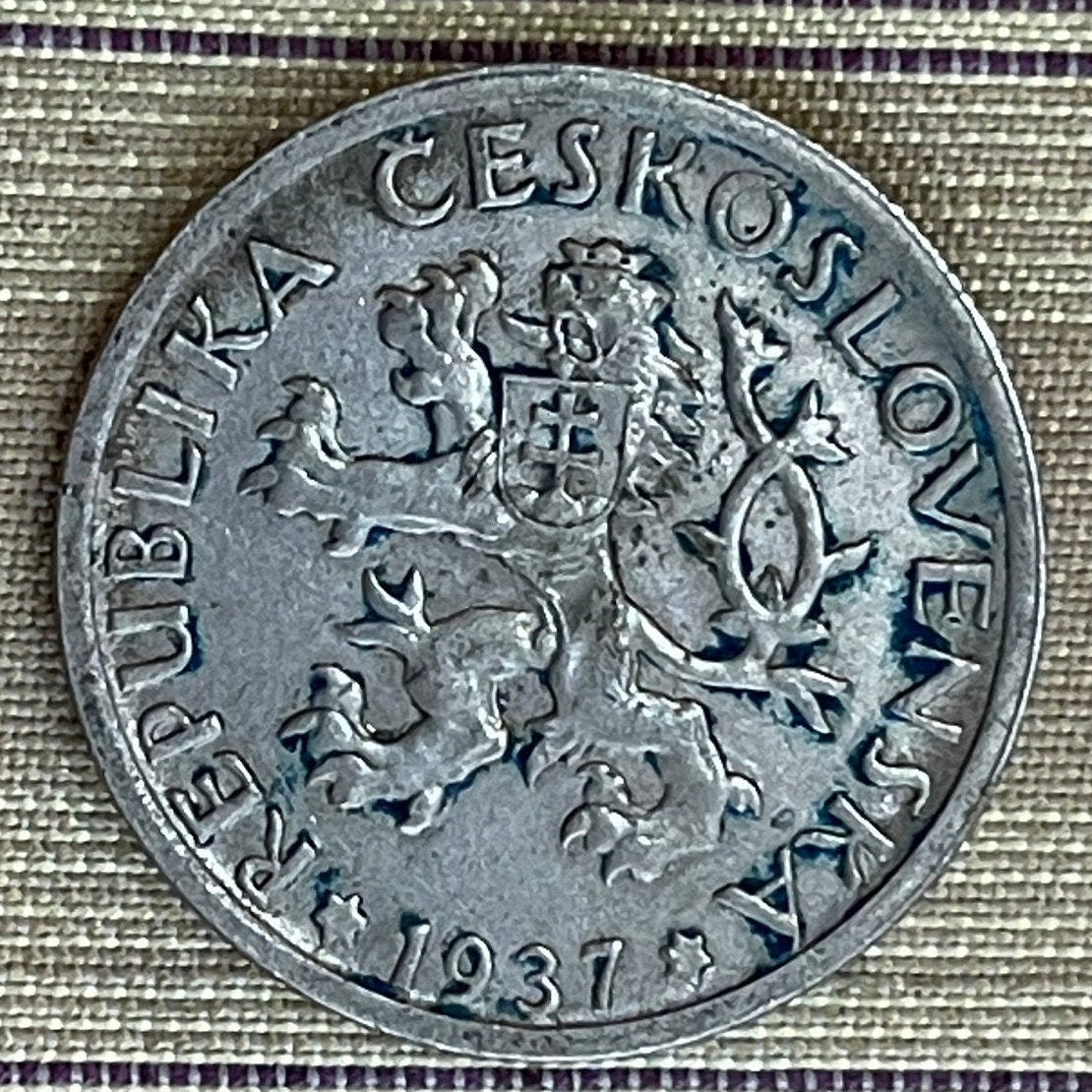elemintalshop
Woman Harvesting & Bohemian Lion 1 Koruna Czechoslovakia Authentic Coin Money for Jewelry (Otakar Spaniel) (Sheaf and Sickle) (Double-Tail)
Woman Harvesting & Bohemian Lion 1 Koruna Czechoslovakia Authentic Coin Money for Jewelry (Otakar Spaniel) (Sheaf and Sickle) (Double-Tail)
Couldn't load pickup availability
Woman Harvesting & Bohemian Lion 1 Koruna Czechoslovakia Authentic Coin Money for Jewelry and Craft Making (Otakar Spaniel) (Sheaf and Sickle) (Double-Tail)
Reverse: Woman with sheaf and sickle
Lettering: 1
O·ŠPANIEL
(Engraver: Otakar Španiel)
Obverse: Bohemian or Czech lion, with Slovak shield
Lettering: REPUBLIKA ČESKOSLOVENSKÁ
Translation: Czechoslovak Republic
Features
Issuer Czechoslovakia
Period First Republic (1918-1938)
Type Standard circulation coin
Years 1922-1938
Value 1 Koruna (1)
Currency Koruna (1919-1939)
Composition Copper-nickel
Weight 6.66 g
Diameter 25 mm
Thickness 1.9 mm
Shape Round
Technique Milled
Orientation Medal alignment ↑↑
Demonetized 30 September 1941
Number N# 1225
References KM# 4, Schön# 7
Wikipedia:
Otakar Španiel (born 13 June 1881 in Jaroměř, died on 15 February 1955 in Prague) was a Czech sculptor and engraver.
Life and career
Španiel was born on 13 June 1881 in Jaroměř. After primary education, he studied at the Engraving School in Jablonec nad Nisou. He would then graduate from the Viennese Academy of Fine Arts in 1901.
In his following years, he continued his studies at the Academy under the guidance of Josef Václav Myslbek, founder of modern Czech sculpting style. He later went to Paris to complete his fine arts education. His stay in Paris was crucial to him, in which he met Antoine Bourdelle, who influenced his distinctive style in his later works. In 1917, he became a professor at the School of Applied Arts in Prague, and from 1919, he was a professor at the Academy of Arts. His work was part of the art competitions at the 1912 Summer Olympics and the 1936 Summer Olympics.
During the Nazi occupation of Czechoslovakia, he was imprisoned in the internment camp in Svatobořice. His brother, General Oldrich Španiel, left Czechoslovakia after the occupation.
Otakar Španiel died on 15 February 1955 in Prague.
*********
From source: https://www.olympedia.org/athletes/920179 :
Otakar Španiel
Biographical information
Type Competed in Olympic Games
Biography
Otakar Španiel was a sculptor, wood carver and medal artist. First, he attended a technical school in Jablonec nad Nisou. From 1899, he was educated at the academy in Wien (Vienna) and by famous sculptor J. V. Myslbek, professor in Praha (Prague), later also with Alexandre Charpentier in Paris. As a professor he taught at the School of Applied Arts beginning in 1917 and two years later at the Academy in Praha. During the German occupation, he was interned in a concentration camp near Svatobořice. Španiel’s style was based on Art Nouveau and then on Neoclassicism. After World War II, he was an official state artist. Španiel was best known for his frequent medal works illustrating Czech VIPs. One of these medals with the face of J. E. Purkyně became the template for a stamp series in 1937. He designed the first Czech coins after World War II and also created his own grave at the famous Prague cemetery Vyšehrad. Some of his works, mainly gold medals and coins, were presented in the exhibition “Czech Gold” in Prague in 2009-10 at the Czech Club of the Municipal House at Prague.
In 1912 he took part under the flag of Bohemia, a part of Austria-Hungary, and in 1936 under that of Czechoslovakia. In 1936 he entered the ČSOV Challenge Award, which bears the name of Bohemian-Czech Olympic pioneer Jiří Guth-Jarkovský. It was awarded from 1934-48 – interrupted by the war – for exceptional sporting achievements, then again from 1994 after a restoration. The trophy consists of a silver statuette of the goddess of victory Nike holding a laurel branch on a marble base. It is decorated with a plaque with a relief portrait by Jiří Guth-Jarkovský.
Results:
Games
1912 Summer Olympics Art Competitions
Sculpturing
1936 Summer Olympics Art Competitions
Sculpturing, Statues
*********
On the Bohemian Lion (or Czech Lion):
https://second.wiki/wiki/bc3b6hmischer_lc3b6we
The particular difference to the other lions in heraldry is its double-tailed shape, which is otherwise not common. In some coats of arms it is turned the other way around, that is, it is heraldically left facing. He is also known as the masked lion from the coat of arms of Ústí nad Labem .
history
The first state symbol of rule for Bohemia was not the lion, but the flame eagle of the Přemyslids , later called the Wenceslas eagle . It can already be found on coins from the time of Prince Bedřich in the 12th century. The Dalimil Chronicle connects the heraldic lion with the award of the royal title to Vladislav in 1156. However, the lion is only reliably documented on the seal of the Moravian margrave Vladislav Heinrich in 1213. [1]
Seal of Ottokar II Přemysl
The twostail is documented from 1248. [2] With the rise of Premysl Otakar II. King, the emblem established as a symbol of the kingdom. The lion, which began in the coats of arms of various rulers, spread in many coats of arms with the expansion of the Bohemian sphere of influence. Examples are Görlitz , Löbau , Plech and Spremberg . Löbau can already prove the lion on a seal from 1254. Also in the coat of arms hall of the Wenzelschloss in Lauf an der Pegnitz there is the Bohemian coat of arms, which demonstrates the former size of the domain.
The Bohemian lion outlived the Přemyslid dynasty and remained the coat of arms of the Kingdom of Bohemia until the end of 1918. It was included in the coat of arms of Czechoslovakia. It occupies an appropriate place in the Czech national coat of arms , as it is one of the national symbols , like the Moravian eagle .
Share










5 stars review from Joy









